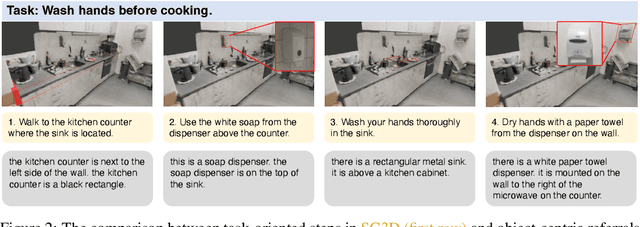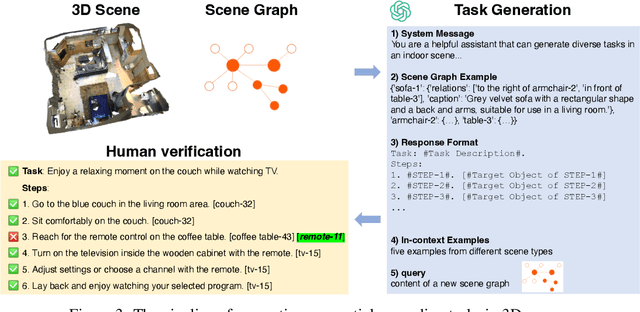Xiaojian Ma
Building LLM Agents by Incorporating Insights from Computer Systems
Apr 06, 2025Abstract:LLM-driven autonomous agents have emerged as a promising direction in recent years. However, many of these LLM agents are designed empirically or based on intuition, often lacking systematic design principles, which results in diverse agent structures with limited generality and scalability. In this paper, we advocate for building LLM agents by incorporating insights from computer systems. Inspired by the von Neumann architecture, we propose a structured framework for LLM agentic systems, emphasizing modular design and universal principles. Specifically, this paper first provides a comprehensive review of LLM agents from the computer system perspective, then identifies key challenges and future directions inspired by computer system design, and finally explores the learning mechanisms for LLM agents beyond the computer system. The insights gained from this comparative analysis offer a foundation for systematic LLM agent design and advancement.
JARVIS-VLA: Post-Training Large-Scale Vision Language Models to Play Visual Games with Keyboards and Mouse
Mar 20, 2025Abstract:Recently, action-based decision-making in open-world environments has gained significant attention. Visual Language Action (VLA) models, pretrained on large-scale web datasets, have shown promise in decision-making tasks. However, previous work has primarily focused on action post-training, often neglecting enhancements to the foundational model itself. In response, we introduce a novel approach, Act from Visual Language Post-Training, which refines Visual Language Models (VLMs) through visual and linguistic guidance in a self-supervised manner. This enhancement improves the models' capabilities in world knowledge, visual recognition, and spatial grounding in open-world environments. Following the above post-training paradigms, we obtain the first VLA models in Minecraft that can follow human instructions on over 1k different atomic tasks, including crafting, smelting, cooking, mining, and killing. Our experiments demonstrate that post-training on non-trajectory tasks leads to a significant 40% improvement over the best agent baseline on a diverse set of atomic tasks. Furthermore, we demonstrate that our approach surpasses traditional imitation learning-based policies in Minecraft, achieving state-of-the-art performance. We have open-sourced the code, models, and datasets to foster further research. The project page can be found in https://craftjarvis.github.io/JarvisVLA.
LongViTU: Instruction Tuning for Long-Form Video Understanding
Jan 09, 2025Abstract:This paper introduce LongViTU, a large-scale (~121k QA pairs, ~900h videos), automatically generated dataset for long-form video understanding. We developed a systematic approach that organizes videos into a hierarchical tree structure and incorporates self-revision mechanisms to ensure high-quality QA pairs. Each QA pair in LongViTU features: 1) long-term context (average certificate length of 4.6 minutes); 2) rich knowledge and condensed reasoning (commonsense, causality, planning, etc.); and 3) explicit timestamp labels for relevant events. LongViTU also serves as a benchmark for instruction following in long-form and streaming video understanding. We evaluate the open-source state-of-the-art long video understanding model, LongVU, and the commercial model, Gemini-1.5-Pro, on our benchmark. They achieve GPT-4 scores of 49.9 and 52.3, respectively, underscoring the substantial challenge posed by our benchmark. Further supervised fine-tuning (SFT) on LongVU led to performance improvements of 12.0% on our benchmark, 2.2% on the in-distribution (ID) benchmark EgoSchema, 1.0%, 2.2% and 1.2% on the out-of-distribution (OOD) benchmarks VideoMME (Long), WorldQA and OpenEQA, respectively. These outcomes demonstrate LongViTU's high data quality and robust OOD generalizability.
Embodied VideoAgent: Persistent Memory from Egocentric Videos and Embodied Sensors Enables Dynamic Scene Understanding
Dec 31, 2024



Abstract:This paper investigates the problem of understanding dynamic 3D scenes from egocentric observations, a key challenge in robotics and embodied AI. Unlike prior studies that explored this as long-form video understanding and utilized egocentric video only, we instead propose an LLM-based agent, Embodied VideoAgent, which constructs scene memory from both egocentric video and embodied sensory inputs (e.g. depth and pose sensing). We further introduce a VLM-based approach to automatically update the memory when actions or activities over objects are perceived. Embodied VideoAgent attains significant advantages over counterparts in challenging reasoning and planning tasks in 3D scenes, achieving gains of 4.9% on Ego4D-VQ3D, 5.8% on OpenEQA, and 11.7% on EnvQA. We have also demonstrated its potential in various embodied AI tasks including generating embodied interactions and perception for robot manipulation. The code and demo will be made public.
Multi-modal Agent Tuning: Building a VLM-Driven Agent for Efficient Tool Usage
Dec 20, 2024Abstract:The advancement of large language models (LLMs) prompts the development of multi-modal agents, which are used as a controller to call external tools, providing a feasible way to solve practical tasks. In this paper, we propose a multi-modal agent tuning method that automatically generates multi-modal tool-usage data and tunes a vision-language model (VLM) as the controller for powerful tool-usage reasoning. To preserve the data quality, we prompt the GPT-4o mini model to generate queries, files, and trajectories, followed by query-file and trajectory verifiers. Based on the data synthesis pipeline, we collect the MM-Traj dataset that contains 20K tasks with trajectories of tool usage. Then, we develop the T3-Agent via \underline{T}rajectory \underline{T}uning on VLMs for \underline{T}ool usage using MM-Traj. Evaluations on the GTA and GAIA benchmarks show that the T3-Agent consistently achieves improvements on two popular VLMs: MiniCPM-V-8.5B and {Qwen2-VL-7B}, which outperforms untrained VLMs by $20\%$, showing the effectiveness of the proposed data synthesis pipeline, leading to high-quality data for tool-usage capabilities.
ROCKET-1: Master Open-World Interaction with Visual-Temporal Context Prompting
Oct 23, 2024Abstract:Vision-language models (VLMs) have excelled in multimodal tasks, but adapting them to embodied decision-making in open-world environments presents challenges. A key issue is the difficulty in smoothly connecting individual entities in low-level observations with abstract concepts required for planning. A common approach to address this problem is through the use of hierarchical agents, where VLMs serve as high-level reasoners that break down tasks into executable sub-tasks, typically specified using language and imagined observations. However, language often fails to effectively convey spatial information, while generating future images with sufficient accuracy remains challenging. To address these limitations, we propose visual-temporal context prompting, a novel communication protocol between VLMs and policy models. This protocol leverages object segmentation from both past and present observations to guide policy-environment interactions. Using this approach, we train ROCKET-1, a low-level policy that predicts actions based on concatenated visual observations and segmentation masks, with real-time object tracking provided by SAM-2. Our method unlocks the full potential of VLMs visual-language reasoning abilities, enabling them to solve complex creative tasks, especially those heavily reliant on spatial understanding. Experiments in Minecraft demonstrate that our approach allows agents to accomplish previously unattainable tasks, highlighting the effectiveness of visual-temporal context prompting in embodied decision-making. Codes and demos will be available on the project page: https://craftjarvis.github.io/ROCKET-1.
Multi-modal Situated Reasoning in 3D Scenes
Sep 04, 2024



Abstract:Situation awareness is essential for understanding and reasoning about 3D scenes in embodied AI agents. However, existing datasets and benchmarks for situated understanding are limited in data modality, diversity, scale, and task scope. To address these limitations, we propose Multi-modal Situated Question Answering (MSQA), a large-scale multi-modal situated reasoning dataset, scalably collected leveraging 3D scene graphs and vision-language models (VLMs) across a diverse range of real-world 3D scenes. MSQA includes 251K situated question-answering pairs across 9 distinct question categories, covering complex scenarios within 3D scenes. We introduce a novel interleaved multi-modal input setting in our benchmark to provide text, image, and point cloud for situation and question description, resolving ambiguity in previous single-modality convention (e.g., text). Additionally, we devise the Multi-modal Situated Next-step Navigation (MSNN) benchmark to evaluate models' situated reasoning for navigation. Comprehensive evaluations on MSQA and MSNN highlight the limitations of existing vision-language models and underscore the importance of handling multi-modal interleaved inputs and situation modeling. Experiments on data scaling and cross-domain transfer further demonstrate the efficacy of leveraging MSQA as a pre-training dataset for developing more powerful situated reasoning models.
Task-oriented Sequential Grounding in 3D Scenes
Aug 07, 2024



Abstract:Grounding natural language in physical 3D environments is essential for the advancement of embodied artificial intelligence. Current datasets and models for 3D visual grounding predominantly focus on identifying and localizing objects from static, object-centric descriptions. These approaches do not adequately address the dynamic and sequential nature of task-oriented grounding necessary for practical applications. In this work, we propose a new task: Task-oriented Sequential Grounding in 3D scenes, wherein an agent must follow detailed step-by-step instructions to complete daily activities by locating a sequence of target objects in indoor scenes. To facilitate this task, we introduce SG3D, a large-scale dataset containing 22,346 tasks with 112,236 steps across 4,895 real-world 3D scenes. The dataset is constructed using a combination of RGB-D scans from various 3D scene datasets and an automated task generation pipeline, followed by human verification for quality assurance. We adapted three state-of-the-art 3D visual grounding models to the sequential grounding task and evaluated their performance on SG3D. Our results reveal that while these models perform well on traditional benchmarks, they face significant challenges with task-oriented sequential grounding, underscoring the need for further research in this area.
UltraEdit: Instruction-based Fine-Grained Image Editing at Scale
Jul 07, 2024Abstract:This paper presents UltraEdit, a large-scale (approximately 4 million editing samples), automatically generated dataset for instruction-based image editing. Our key idea is to address the drawbacks in existing image editing datasets like InstructPix2Pix and MagicBrush, and provide a systematic approach to producing massive and high-quality image editing samples. UltraEdit offers several distinct advantages: 1) It features a broader range of editing instructions by leveraging the creativity of large language models (LLMs) alongside in-context editing examples from human raters; 2) Its data sources are based on real images, including photographs and artworks, which provide greater diversity and reduced bias compared to datasets solely generated by text-to-image models; 3) It also supports region-based editing, enhanced by high-quality, automatically produced region annotations. Our experiments show that canonical diffusion-based editing baselines trained on UltraEdit set new records on MagicBrush and Emu-Edit benchmarks. Our analysis further confirms the crucial role of real image anchors and region-based editing data. The dataset, code, and models can be found in https://ultra-editing.github.io.
OmniJARVIS: Unified Vision-Language-Action Tokenization Enables Open-World Instruction Following Agents
Jun 27, 2024



Abstract:We present OmniJARVIS, a novel Vision-Language-Action (VLA) model for open-world instruction-following agents in open-world Minecraft. Compared to prior works that either emit textual goals to separate controllers or produce the control command directly, OmniJARVIS seeks a different path to ensure both strong reasoning and efficient decision-making capabilities via unified tokenization of multimodal interaction data. First, we introduce a self-supervised approach to learn a behavior encoder that produces discretized tokens for behavior trajectories $\tau$ = {$o_0$, $a_0$, $\dots$} and an imitation learning (IL) policy decoder conditioned on these tokens. These additional behavior tokens will be augmented to the vocabulary of pretrained Multimodal Language Models (MLMs). With this encoder, we then pack long-term multimodal interactions involving task instructions, memories, thoughts, observations, textual responses, behavior trajectories, etc. into unified token sequences and model them with autoregressive transformers. Thanks to the semantically meaningful behavior tokens, the resulting VLA model, OmniJARVIS, can reason (by producing chain-of-thoughts), plan, answer questions, and act (by producing behavior tokens for the IL policy decoder). OmniJARVIS demonstrates excellent performances on a comprehensive collection of atomic, programmatic, and open-ended tasks in open-world Minecraft. Our analysis further unveils the crucial design principles in interaction data formation, unified tokenization, and its scaling potentials.
 Add to Chrome
Add to Chrome Add to Firefox
Add to Firefox Add to Edge
Add to Edge